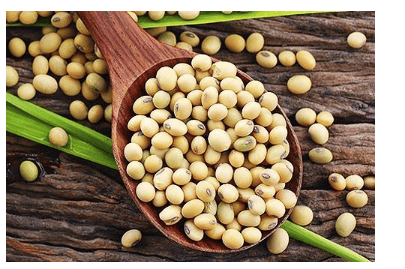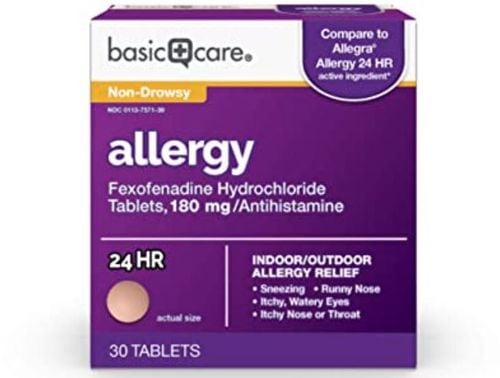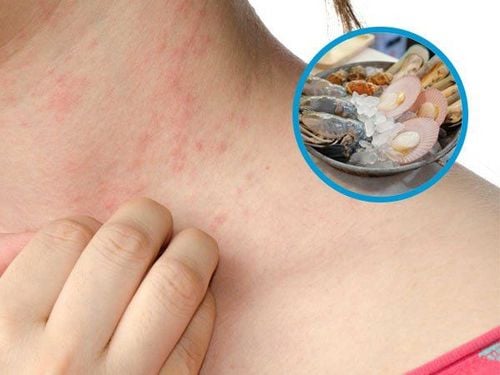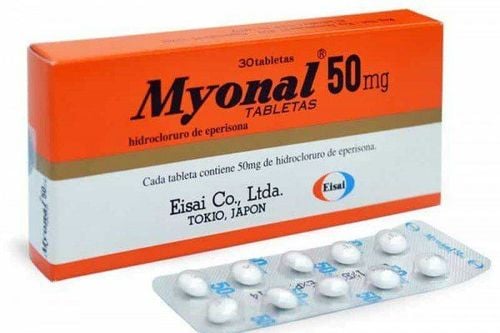This is an automatically translated article.
Any food can cause an allergic reaction. However, only a few foods cause at least 90% of an allergic reaction to a food. The substance that causes an allergic reaction in a food or drink is called an “allergen”. In terms of food, nearly all allergens are proteins. For most people, these proteins are not allergens, because their immune system doesn't react to them. It is the immune system's response to these proteins that causes an allergic reaction. In this article, we will provide useful information to help you better understand the most common foods that cause allergies.1. What is a food allergy?
A food allergy is a condition in which certain foods cause the body's abnormal immune response to that food.The cause of a food allergy is that the immune system of the person who eats that food source incorrectly recognizes certain proteins in the food as harmful. The person's body then initiates a series of protective measures including the release of substances such as histamine and inflammatory substances. For people who are allergic to certain foods, even if they are exposed to even a small amount of that food, the body will continue to protect the body.
Symptoms of a food allergy can occur any time, from a few minutes to a few hours after exposure to that food, symptoms can appear such as:
Shortness of breath Low blood pressure Vomiting Vomiting Diarrhea Itching Rash In more severe cases, a food allergy can cause anaphylaxis. Symptoms that can come on quickly include an itchy rash, swelling of the throat or tongue, difficulty breathing, and a drop in blood pressure. In some severe cases, the user can be fatal.
Food allergies can be divided into 2 main types: IgE antibodies or non-IgE antibodies. An antibody is a protein in the blood that is used by the immune system to recognize and fight infection. In IgE food allergies, IgE antibodies are released by the body's immune system. In the case of a non-IgE food allergy, IgE antibodies are not released and other parts of the immune system are used to fight the perceived threat.
It is important to distinguish a food allergy from a food intolerance. Food intolerance reflects an abnormality in metabolic function related to the ability to digest food. The main cause of this condition is that the body lacks a specific digestive enzyme, then the body will build a mechanism to excrete, consider that food a toxic product. When allergic, the body will produce histamine and cause characteristic symptoms. The manifestation of food intolerance is often slower (sometimes up to a few days after eating), is not related to immunity, so this condition only affects the quality of life, not the life of the user. use.

Dị ứng thực phẩm là tình trạng một số loại thực phẩm gây ra phản ứng miễn dịch bất thường của cơ thể đối với loại thực phẩm đó
2. Allergenic foods
2.1. Cow's milk allergy Cow's milk allergy is the most common allergy in infants and young children, especially those under 6 months of age who are exposed to cow's milk proteins. It is one of the most common childhood allergies, affecting 2 to 3% of babies and toddlers. However, about 90% of children will clear their allergy to that food by the time they are 3 years old. Cow's milk allergy can occur in both IgE and non-IgE forms, but IgE cow's milk allergy is the most common and potentially the most severe. Children or adults who are allergic to cow's milk usually have a reaction within 5 to 30 minutes of drinking cow's milk. People with allergies will then show many symptoms such as swelling, rash, hives, vomiting and in rare cases, anaphylaxis. Non-IgE allergies are more often associated with intestinal symptoms such as vomiting, constipation, or diarrhea, as well as inflammation of the intestinal wall. Non-IgE milk allergy can be quite difficult to diagnose. The reason for this is that sometimes the symptoms can resemble an intolerance and there is no blood test for itWhen the subject consumes cow's milk and is certain to have a cow's milk allergy, what should be the treatment? The only treatment is to avoid cow's milk and foods containing cow's milk such as milk, powdered milk, cheese, butter, margarine, yogurt, ice cream,... For nursing mothers with children Allergy sufferers may have to exclude cow's milk and foods containing cow's milk from their diet. For babies who are not breastfed, health professionals recommend alternatives to formulas made from cow's milk.
2.2. Eggs Eggs are considered the second most common source of food allergies in children. However, 68% of children with an egg allergy will develop an allergy by the time they are 16 years old. Typical symptoms are:
Gastrointestinal disturbances, such as abdominal pain Skin reactions, such as rash Respiratory tract problems Anaphylaxis (rare) Egg allergy may only be caused by an allergic reaction egg white or only egg yolk because the protein composition of egg white and egg yolk is different. However, most allergenic proteins are found in egg whites, so allergies by egg whites are more common. The most effective treatment is still to eliminate eggs from the diet. However, it is not necessary for people who are allergic to eggs to avoid all egg-related foods because when eggs are heated, the allergen proteins can change shape and become less. less likely to cause a reaction.

Dị ứng trứng có thể chỉ dị ứng bởi lòng trắng trứng hoặc chỉ lòng đỏ trứng do thành phần protein ở lòng trắng và lòng đỏ trứng là khác nhau
2.4. Peanuts Like tree nut allergies, peanut allergies are very common and can cause serious and potentially fatal allergic reactions. People with a peanut allergy are also often allergic to tree nuts. Peanut allergy affects about 4-8% of children and 1–2% of adults. However, about 15–22% of children with peanut allergies will clear up on their own by the time they reach adolescence.
People with a family history of peanut allergy often have a higher risk of developing the disease than people with normal, healthy families. Many people fear when pregnant women can have allergies and affect the fetus, but studies have shown that early introduction of peanuts into the body can have a protective effect. The most effective treatment is to completely avoid peanuts and products containing peanuts.

Cũng giống như dị ứng hạt cây, dị ứng đậu phộng rất phổ biến và có thể gây ra các phản ứng dị ứng nghiêm trọng và có khả năng gây tử vong
2.6. Wheat A wheat allergy is an allergic reaction to one of the proteins found in wheat. Commonly seen in children, it can cause gastrointestinal distress, hives, vomiting, rash, swelling and, in severe cases, anaphylaxis and death. Parents sometimes confuse celiac disease and non-celiac gluten sensitivity, which can have similar digestive symptoms. People with a wheat allergy simply need to avoid wheat and can tolerate gluten from wheat-free grains. The only treatment is to avoid wheat and wheat-containing products, including beauty products.
2.7. Soy Soy allergy affects about 0.4% of all children, especially in infants and children under 3 years of age. Common foods that cause soy allergies include soybeans and soy products such as soy milk or soy sauce. Therefore, care should be taken when using soy products to avoid allergies.

Dị ứng đậu nành chiếm đến khoảng 0,4% tổng số trẻ em, đặc biệt ở những trẻ sơ sinh và trẻ em dưới 3 tuổi
2.8. Fish Allergy to fish accounts for about 2% of adults, allergies are common. Like a shellfish allergy, a fish allergy can cause a serious and potentially fatal allergic reaction. The main symptoms are vomiting and diarrhea, but in rare cases anaphylaxis can also occur. This means that people who are allergic to fish are often given injectors in case they accidentally ingest fish or fish products, and because shellfish and finfish do not carry the same a protein, people with shellfish allergies may not be allergic to fish.
Above are 8 common food allergies in both adults and children. Besides, there are still some foods that can also cause allergies such as sesame seeds, peaches, bananas, avocados, kiwi, passion fruit, ... so when you find out that you are likely to be allergic to foods. Which should be noted and avoided, to avoid affecting health.
Any questions that need to be answered by a specialist doctor as well as customers wishing to be examined and treated at Vinmec International General Hospital, please contact the Website for the best service.
Please dial HOTLINE for more information or register for an appointment HERE. Download MyVinmec app to make appointments faster and to manage your bookings easily.
References: theicn.org, healthline.com












